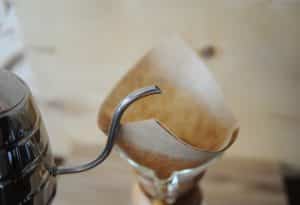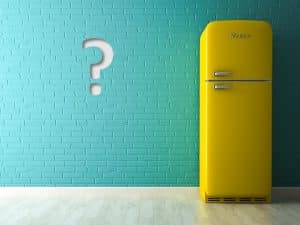
Can you reuse Chemex filters? We have the answer!
The Chemex coffee maker is one of the great classic pour-over coffee makers. You can make fantastic coffee with one, and as a bonus, it
The AeroPress coffee maker is one of the great innovations in coffee of the past 20 years. A lightweight, durable, and relatively cheap device that will make you excellent coffee every time.
I believe the AeroPress is the ultimate coffee maker. And I think it is pretty easy to use. The most common problem with the AeroPress people ask me about is the resistance they feel while plunging. Sometimes people find it difficult to press the AeroPress. That’s not because they need to go to a gym and gain some muscle. There is another problem.
So, why is your AeroPress be difficult to press? When an AeroPress is difficult to press down (to “plunge”), the coffee is ground too fine. A bed of saturated coffee that has been ground too fine is a tough barrier for the water to flow through. The solution is to grind your coffee beans a bit coarser next time you make coffee with your AeroPress.
Of course, there is more to it.
Below we explain in more detail why your AeroPress might be difficult to press. We also have an excellent AeroPress brew method for you. Finally, we answer some more frequently asked questions on brewing coffee with an AeroPress.
But let’s start with the plunging difficulties some people experience.

We covered this one in the introduction because this is by far the most common problem. The finer you grind your coffee beans, the more it becomes a barrier for the water to go through.
But you want the ground coffee to form a barrier for the water. The AeroPress is designed to force water through a ‘puck’ of ground coffee.
Think of it as an espresso machine. To brew espresso, you fill the portafilter with ground coffee, and you apply pressure with a coffee tamper to form a solid puck of ground coffee. The espresso machine then forces hot water through the puck, ideally with 9 bars of pressure. What makes espresso taste like espresso is the combination of the coffee bean, the water temperature, the duration of the brew, AND the pressure at which the water is forced through the puck.
While you can’t apply 9 bars of pressure with the AeroPress, pressure is one of the factors that make AeroPress coffee taste so good.
And some AeroPress brew methods ask for a very fine grind, which can make your AeroPress difficult to press. So for you to be able to plunge the AeroPress, you need to grind it bit coarser.
A real problem occurs when your grinder cannot produce an even grind. A bad quality or broken burr coffee bean grinder can produce ground coffee with particles that have different sizes. This uneven grind is bad news for your coffee. Some particles (large ones) will under-extract, some (small ones) will over-extract. Under-extraction and over-extraction produce off-flavors in your coffee (sourness, bitterness, etcetera).
But the real problems are the smallest particles a bad quality or broken grinder produces. These fines, or coffee dust, prevent the water from flowing around the properly sized particles in the ground coffee.
Too much fines can form a nearly impenetrable barrier for the water and make you AeroPress impossible to plunge.
Not only bad quality or broken burr coffee grinders produce too much fines. The bane of the barista, the blade grinder, is the king of fines. I don’t want to come off as some snob, but a blade grinder is terrible news for your coffee. The blade grinder does one thing very well. And that is to produce an uneven grind.
An excellent manual coffee grinder doesn’t need to be expensive. As a matter of fact, in our round-up of the best hand-powered coffee bean grinders, you’ll find several that doesn’t cost more than an AeroPress.
When you do have a quality burr grinder, there might be another reason your ground coffee contains too much fines. If the burrs in your grinder are no longer sharp, they will produce an uneven grind. An uneven grind contains a lot of coffee dust, which makes your AeroPress difficult to press.
If you think this might be the problem, please consider reading our article on how to check whether the burrs in your grinder are dull.
While the AeroPress can’t make ‘real’ espresso (i.e., espresso should be made with 9 bars of pressure), it absolutely can make a coffee that tastes a lot like a real espresso. That means it can make espresso if you ask me.
But that’s just me.
The difference between an espresso machine and an AeroPress espresso is that you should not apply pressure to the ground coffee in an AeroPress. The ground coffee does not need to be tamped in the brew chamber of the AeroPress.
If you do, you might create problems when it is time to plunge.
An AeroPress that is difficult to press is probably the most common problem with the AeroPress. At least, it is the one I get asked about the most. But there are a couple more issues that you might face.
A bitter cup of coffee is usually the result of an extraction that went on for too long. My best advice is to try two things. First, grind your coffee a bit finer. This will help speed up the extraction and produce less bitter flavors. Second, you should speed up the brew. Reduce the time you steep the coffee. See how that works, and if it is still too bitter, shorten your brew time even more.
Most AeroPress brew recipes ask for only one minute of steeping time. If you steep for far longer than one minute, check your recipe.
A sour cup of coffee is usually the result of under-extraction. Try to brew for a bit longer, or try to grind your coffee beans finer.
When you use the original method, some liquid will leak through the filter into your cup. You can’t stop it. And there is no need to.
It is perfectly normal for up to 5% of the total volume to leak through during the brewing process. If you experience a lot more leak through, make sure you level the ground by shaking the AeroPress before you add water.
Let me just say it.
There is no ‘best’ AeroPress recipe.
There are loads of great AeroPress recipes, though.
Heck, there is even a World AeroPress Championship!
My advice, stop looking for the best recipe out there. Start with the recipe from AeroPress (check the demo below), and then start experimenting.
Be sure to check out the inverted method; it is very popular. But you can find many recipes on the web.
Especially YouTube is a great source.
Something I have been experimenting with is the winning recipe from the World AeroPress Championships 2019. The video below explains the method (and by the way: European Coffee Trip is a great coffee channel on YouTube, be sure to check them out!).
When I find a recipe that I like, I’ll use it anywhere from a couple of weeks to a couple of months. Eventually, I’ll be in the mood for something new, and I’ll look for my next experiment. And that’s a great thing with the AeroPress. It is excellent as it is, but you can experiment infinitely.
MonsieurCoffee.com is a participant in the Amazon Services LLC Associates Program, an affiliate advertising program designed to provide a means for sites to earn advertising fees by advertising and linking to Amazon.com. We earn small commissions on purchase made through links on this site, at no extra costs to you.

The Chemex coffee maker is one of the great classic pour-over coffee makers. You can make fantastic coffee with one, and as a bonus, it

During hot summer days, there is a good chance you like your coffee iced. For this and for all your other favorite cold coffee drinks,

I had a discussion with a friend the other day. He stated that coffee is actually a tea. I was dumbstruck. How can you say

Over the years, Starbucks has become the most successful coffee shop in the world. It has over 32,000 stores worldwide, more than 15,000 in the